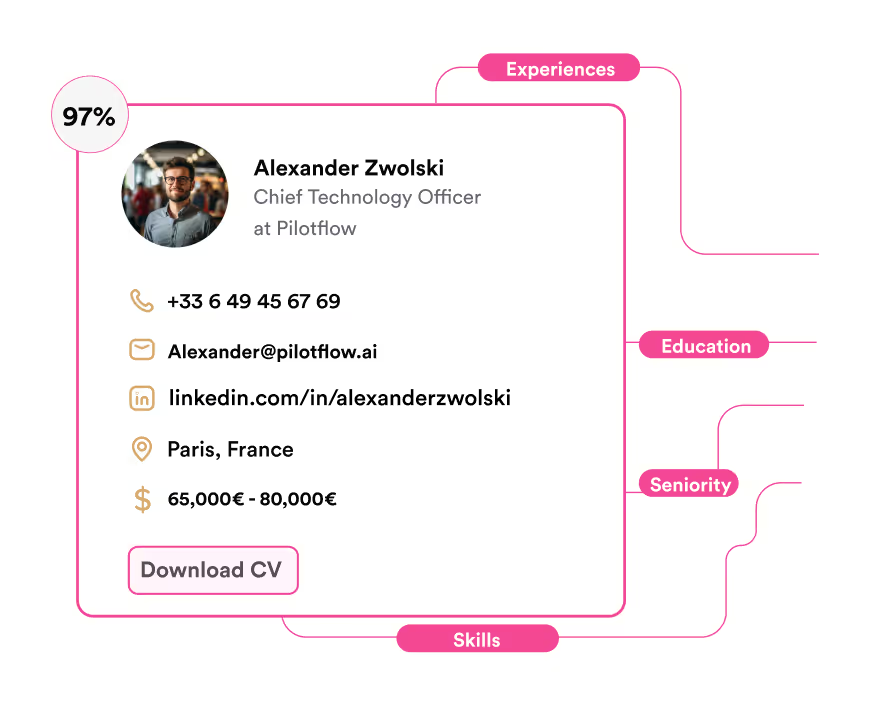Recrutement à l'étranger en 2024 : ce que vous devez savoir
Tout ce que vous devez savoir sur le recrutement sortant en 2024 pour le maîtriser et faire passer votre recrutement au niveau supérieur. Découvrez les meilleures techniques et comment les mettre en œuvre.
Understanding Outbound Recruiting
Outbound recruiting, inspired by marketing tactics, is about actively looking for and reaching out to potential candidates rather than waiting for them to apply.
This proactive approach is particularly effective in sectors where qualified candidates are rare.
Why Outbound Recruiting Is Important
Find Nuggets 💎
Outbound recruiting allows businesses to find candidates with rare skills and specific expertise, essential for roles that require a high level of technical knowledge or experience.
Efficient Selection and Sorting 🏆
By directly targeting candidates who meet the job criteria, outbound recruiting reduces the time spent sorting through unsuitable applications.
This method ensures that recruiters focus on the most promising prospects.
Building Stronger Connections 🧠
Approaching candidates directly can improve their perception of your business, making it more accessible and committed to finding the right profile.
This method promotes stronger relationships from the start.
Key Benefits of Outbound Recruiting
- Identifying the best talent: Proactively search for the best candidates, making sure to find individuals who perfectly match your needs.
- Simplified verification: Prioritize skills testing, saving time by hiring only highly qualified candidates.
- Reinforcing the attractiveness of the employer: Make your business more attractive to potential candidates by contacting them directly and showing genuine interest in their profiles.
When to Use Outbound Recruiting Instead of Inbound
In competitive talent markets
In sectors with a high demand for specialized skills, such as IT and management, outbound recruitment is essential.
By actively seeking candidates, businesses can secure top talent before their competitors.
For positions of high responsibility
For senior roles, outbound recruiting excels in providing access to detailed information about candidates, including their experience, skills, and recommendations.
This thorough vetting process ensures that the best profile is selected for critical positions.
Recap: Outbound vs. Inbound
- Inbound recruitment: Candidates come to you.
- Outbound recruitment: You are looking for candidates.
- Specialized talents: Outbound is ideal for finding rare skills.
- Investment in time: Outbound requires a lot of time, but it is very rewarding.
Steps to Implement an Outbound Recruiting Strategy

1. Define Target Personas
Create detailed profiles of your ideal candidates (personas) to guide your search. Focus on key characteristics such as skills, experience, and current roles.
2. Choosing the Right Recruiting Channels
- Talent sourcing: Use tools and platforms like LinkedIn Recruiter or Kalent to search for potential candidates.
- Recruiting on Social Networks: Engaging talent on platforms like LinkedIn, Twitter, or Facebook.
- Cold emailing campaigns: Send personalized emails to talented profiles that match your company's recruitment criteria.
- Co-optation programs: Encourage current employees to recommend qualified candidates for open positions.
- Event recruitment: Participate in job fairs, conferences, and meetups to connect with potential candidates.
3. Search for talent with Outbound sourcing
- Cold approach: Source potential candidates with whom you have not had any prior contact.
- Hot approach: Contact candidates who have already interacted with your company, for example during events or past applications.
- Referral Based Approach: Use your current employees or network to find potential candidates who may be a good fit.
Use social networks and specialized platforms to find candidates. LinkedIn is valuable for broad searches, while niche platforms like GitHub (for developers) and Behance (for designers) can be particularly useful.
Your talent shortlist should be a qualified segment of 20 to 100 interesting profiles.
Kalent 🧠 can help you in this process to find the most qualified candidates and save time in your sourcing.
4. Improving Your Employer Brand
Make sure your business's online presence is engaging.
Candidates will research your business, so make sure your website, social media, and reviews reflect your strengths.
5. Writing Personalized Contact Messages
Adapt your messages to each candidate.
Highlight your business goals and explain why their profile caught your attention. Personalization increases the chances of receiving a positive response.
When approaching, especially for cold prospecting, be sure to include:
- Job Details: The proposed role, its missions, the salary range and the opportunities for growth.
- Company Information: The work environment, company values, culture, and benefits.
- Call to action: A clear invitation to schedule an interview or at least get an answer.
6. Maintaining connections
Even if a candidate is not immediately available, keeping in touch can pay off later. Building a network of potential future employees can be invaluable.
The Pros and Cons of Outbound Recruiting
Benefits
- Reach a greater number of qualified candidates: Including those who would not have applied otherwise.
- A better quality of employment: Thanks to an approach that is more targeted at profiles that are better suited to your specific needs.
- Reduction in Hiring Time and Cost: Because you don't just depend on job ads.
- Competitive advantage: Find the best talent before your competitors.
- Strengthening Your Employer Brand: Showing that you are proactive and invested in finding the best talent.
Disadvantages
- Time-consuming and demanding in terms of resources: Involves a more proactive and personalized approach.
- Higher rejection rates: Not all candidates contacted will be interested or available.
- Variability in efficiency: May not be effective for all types of positions.
- Technology adoption: New technology can be difficult to master if you are not comfortable using digital tools such as a recruitment CRM.
Outbound Recruiting Tools
Recruteur LinkedIn
LinkedIn Recruiter est l'outil de sourcing le plus connu et pour cause : la plupart des professionnels sont présents sur LinkedIn. LinkedIn Recruiter vous aide à trouver plus efficacement les candidats appropriés. Il s'agit d'une plateforme de recrutement qui facilite la recherche, la sélection et la gestion des candidats. L'outil utilise les informations de la communauté active de LinkedIn pour réduire le temps de recrutement global. Vous pouvez également contacter facilement un grand nombre de candidats grâce à sa fonction de messagerie groupée.
Kalent AI, le copilote IA pour les recruteurs
Trouvez les meilleurs talents en quelques clics
Kalent AI effectue des recherches parmi 1 milliard de profils LinkedIn pour identifier et associer rapidement à l'IA les candidats les plus qualifiés pour vos offres d'emploi. Il ne vous reste plus qu'à glisser-déposer votre offre d'emploi et Kalent s'occupe du reste !

messagerie Multicanal automatisé
Avec Kalent, vous pouvez automatiser votre prospection via LinkedIn, e-mail et WhatsApp. Cette approche multicanale augmente vos chances d'engager les meilleurs candidats et Réduire le « temps nécessaire à l'entretien » par 3.

Conclusion : le recrutement sortant en 2024 est essentiel pour la recherche des meilleurs talents
Le recrutement sortant ne remplacera pas les méthodes ou pratiques traditionnelles, mais il est essentiel de l'ajouter à votre stratégie et de l'associer à Le trafic entrant Et le Cooptation pour tirer le meilleur parti de vos futures recrutements.
Comme le marketing allbound mais adapté au recrutement ⭐




